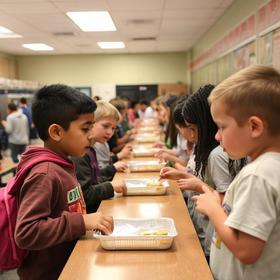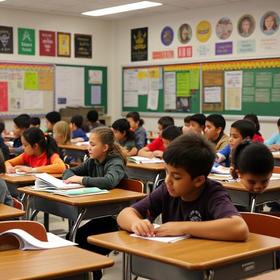Top Rankings
Cyber Village Academy School District ranks among the top 20% of public school district in Minnesota for:
Category
Attribute
Diversity
Most diverse schools (Top 1%)
Student Attention
Lowest student-teacher ratio (Top 1%)
For the 2025-26 school year, there are 5 public charter schools serving 219 students in Cyber Village Academy School District. This district's average charter testing ranking is 6/10, which is in the top 50% of public charter schools in Minnesota.
Public Charter Schools in Cyber Village Academy School District have an average math proficiency score of 28% (versus the Minnesota public charter school average of 31%), and reading proficiency score of 40% (versus the 42% statewide average).
Minority enrollment is 42% of the student body (majority Black), which is less than the Minnesota public charter school average of 65% (majority Black).
Overview
This School District
This State (MN)
# Schools
5 Schools
315 Schools
# Students
219 Students
69,887 Students
# Teachers
22 Teachers
4,947 Teachers
Student-Teacher Ratio
10:1
10:1
Student By Grade
District Rank
Cyber Village Academy School District, which is ranked within the bottom 50% of all 520 school districts in Minnesota (based off of combined math and reading proficiency testing data) for the 2022-2023 school year.
The school district's graduation rate of 50% has increased from 40-49% over five school years.
Overall District Rank
#328 out of 525 school districts
(Bottom 50%)
(Bottom 50%)
Math Test Scores (% Proficient)
26%
46%
Reading/Language Arts Test Scores (% Proficient)
45-49%
51%
Science Test Scores (% Proficient)
30-34%
41%
Graduation Rate
50%
84%
Students by Ethnicity:
Diversity Score
0.62
0.75
% American Indian
2%
1%
% Asian
3%
16%
% Hispanic
10%
12%
% Black
18%
31%
% White
58%
35%
% Hawaiian
n/a
n/a
% Two or more races
9%
5%
All Ethnic Groups
District Revenue and Spending
The revenue/student of $19,000 is higher than the state median of $17,860. The school district revenue/student has grown by 22% over four school years.
The school district's spending/student of $18,676 is higher than the state median of $18,585. The school district spending/student has grown by 22% over four school years.
Total Revenue
$4 MM
$15,547 MM
Spending
$4 MM
$16,179 MM
Revenue / Student
$19,000
$17,860
Spending / Student
$18,676
$18,585
Best Cyber Village Academy School District Public Charter Schools (2025-26)
School
(Math and Reading Proficiency)
(Math and Reading Proficiency)
Location
Quick Facts
Rank: #11.
Cva Fusion High School (9-12)
Charter School
(Math: <50% | Reading: ≥50%)
Rank:
Rank:
7/
Top 50%10
3810 East 56th Street
Minneapolis, MN 55417
(651) 523-7170
Minneapolis, MN 55417
(651) 523-7170
Gr: 9-12 | 56 students Student-teacher ratio: 6:1 Minority enrollment: 32%
Rank: #22.
Cva Fusion Elementary School (K-5)
Charter School
(Math: 21-39% | Reading: ≥50%)
Rank:
Rank:
5/
Bottom 50%10
3810 East 56th Street
Minneapolis, MN 55417
(651) 523-7170
Minneapolis, MN 55417
(651) 523-7170
Gr: K-5 | 33 students Student-teacher ratio: 7:1 Minority enrollment: 24%
Rank: #33.
Cva Fusion Middle School (6-8)
Charter School
(Math: 20-29% | Reading: 40-49%)
Rank:
Rank:
3/
Bottom 50%10
3810 East 56th Street
Minneapolis, MN 55417
(651) 523-7170
Minneapolis, MN 55417
(651) 523-7170
Gr: 6-8 | 40 students Student-teacher ratio: 13:1 Minority enrollment: 38%
Rank: #44.
Cva Pascal Middle & High School
Charter School
(Math: ≤10% | Reading: 20-29% )
Rank:
Rank:
1/
Bottom 50%10
3810 East 56th Street
Minneapolis, MN 55417
(651) 523-7170
Minneapolis, MN 55417
(651) 523-7170
Gr: 6-12 | 73 students Student-teacher ratio: 18:1 Minority enrollment: 49%
Rank: n/an/a
Cva Pascal Elementary School (K-5)
Charter School
3810 East 56th Street
Minneapolis, MN 55417
(651) 523-7170
Minneapolis, MN 55417
(651) 523-7170
Gr: K-5 | 17 students Student-teacher ratio: 17:1 Minority enrollment: 88%
Recent Articles

How Public Schools Support Students on Free / Reduced-Lunch Programs
Explore how U.S. public schools support students eligible for free or reduced-price lunch through nutrition, academic, and wraparound services in 2025.

Hidden Costs of Public Schools: Fees, Supplies & Extras
Explore the hidden costs in public schools—fees, supplies, extracurriculars—and how parents can plan for them in 2025.

Public School Funding 2025: What Families Should Know
Essential insights on public school funding in 2025—how it works, what’s changing, and what families should know to stay ahead.





